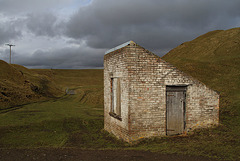
Durham
Brandon Walls kilns
| |
|
Disused limekilns high up above Weardale. These took a bit of finding as they were well hidden amongst the trees. There appeared to be two kilns with each pot being served by two draw holes.
Pease
| |
|
|
J.W. Pease and Partners, and later Pease and Partners Ltd. had extensive mining, quarrying and ironworks interests in Durham and Yorkshire. This is an example of the product from one of their ancillary brickworks.
Decoy
| |
|
At the side of the road from the Middlesbrough Transporter Bridge across Seal Sands towards Hartlepool stands this pair of structures. They comprise (left) the generator/command bunker and (right) shelter of a WWII decoy site. Both buildings were originally covered with earth. The command bunker was connected to a Starfish Decoy some distance away across the marshes. This would have been lit to give the impression of burning buildings to lure bombers away from their intended targets along the Tees.
The background features the Huntsman Tioxide, Greatham Works.
Exchange sidings
| |
|
AB 2274 shunting wagons at the exchange sidings behind the colliery row at Beamish. The appearance of the sun at the end of the photo charter gave some splendid opportunities to round off the day.
Weighbridge
| |
|
The Bishopley limestone quarries at Frosterley flourished during the nineteenth and first decades of the twentieth century. Closed by the 1940s, all that remains apart from the grassed over quarries are two massive banks of limekilns and this weighbridge building that once weighed the railway wagons into and out of the site.
High Greenfield
| |
|
Single limekiln high up above Weardale. It appears to have been working during the nineteenth century and possibly early 20th century.
Under the screens
| |
|
Head Wrighton No.1 shunts chaldrons under the screens at the Beamish colliery during the recent photo charter. This locomotive can be quite alarming as from certain angles it appears to be running without a driver!
Durham colliery steam
| |
|
AB 2274, on loan from the Bowes Railway, is shunting chaldrons at Beamish during the recent charter at the museum.
Groverake
| |
|
|
The Groverake Mine, Rookhope, Weardale, Durham, began life as a lead mine but became a major producer of fluorspar in the second half of the twentieth century. After several years of financial problems the mine finally closed in 1999, unable to compete with low Chinese prices.
Bantling Castle limekilns
| |
|
This block of six kilns known as East Castle or Bantling Castle limekilns are built in an arc and stand about 35ft high. They were constructed between 1835 and 1836 for the Stanhope and Tyne Railway, and were built to supplement the output from kilns owned by the same company in Consett. The kilns were fed with limestone by a siding off the Stanhope and Tyne Railway, the coal was provided by two adjacent collieries, a mine and a series of drifts to the west and east of the site. The Stanhope and Tyne Railway Company was very short lived with the company going bankrupt in the late 1830s. The limekilns were then bought by the Derwent Iron Company of Consett in 1842, with much of the production of the limekilns going to their works at Consett. The burned lime appears to have been removed by small carts, as there does not appear to be any provision of any siding at this level or incline and no obvious remains of any substantial tracks at the base of the lime kilns. Production seems to have ended here around 1850 and the kilns have partly collapsed in the intervening years, although some stabilisation and restoration has been undertaken by the local Groundwork Trust.
Steam at the end of the ginnel
| |
|
|
AB 2274 shunts chaldron type wagons at the exchange sidings for the Beamish Colliery.
Puddingthorn Pastures
| |
|
|
This limekiln is situated in a remote spot in the west of Durham and I accessed the site via a very muddy track that rejoices in the appropriate name of 'Clarty Lane'.
Rounding the shed
| |
|
AB 2274 charges around the corner by the locomotive shed with empties from the exchange sidings towards the colliery at Beamish.
In the shed
| |
|
|
|
Industrial narrow gauge locomotives inside the locomotive shed at the Beamish Colliery site.
West Crag kiln
| |
|
|
|
On a visit to County Durham I took the opportunity to seek out some of the old limekilns in the more obscure corners of the countryside. To find this one I had to walk quite a distance through woods and cross a river. It has clearly seen better days and the face over one of the two draw tunnels has collapsed.
Coffee Pot under the screens
| |
|
|
|
Head Wrightson No.1 shunts the chaldron type wagons under the screens at Beamish Colliery. The engine house in the background contains a single cylinder vertical winding engine built by Thomas Murray at Chester-le-Street in 1844. It was originally in service at Fortune Pit, Burnhope Colliery.
Kiln top
| |
|
This depression is the filled-in bowl of the limekiln close to Rogerley Hall, Frosterley. This is much safer than the many open kilns that can be found across Britain.
Rogerley Hall kiln
Jump to top
RSS feed- Latest items - Subscribe to the latest items added to this album
- ipernity © 2007-2025
- Help & Contact
|
Club news
|
About ipernity
|
History |
ipernity Club & Prices |
Guide of good conduct
Donate | Group guidelines | Privacy policy | Terms of use | Statutes | In memoria -
Facebook
Twitter


















